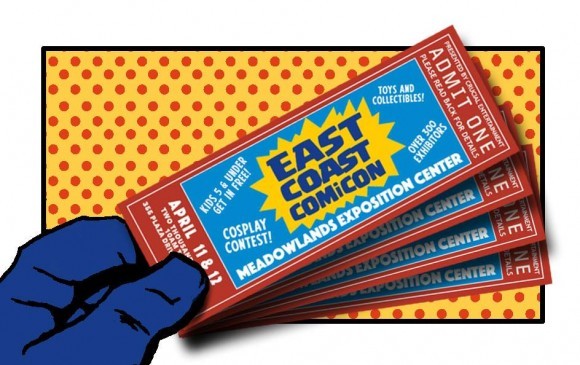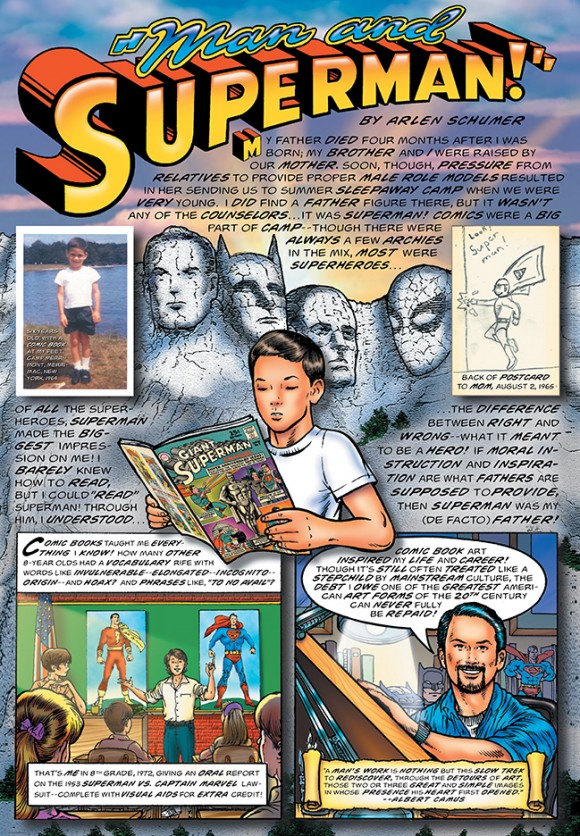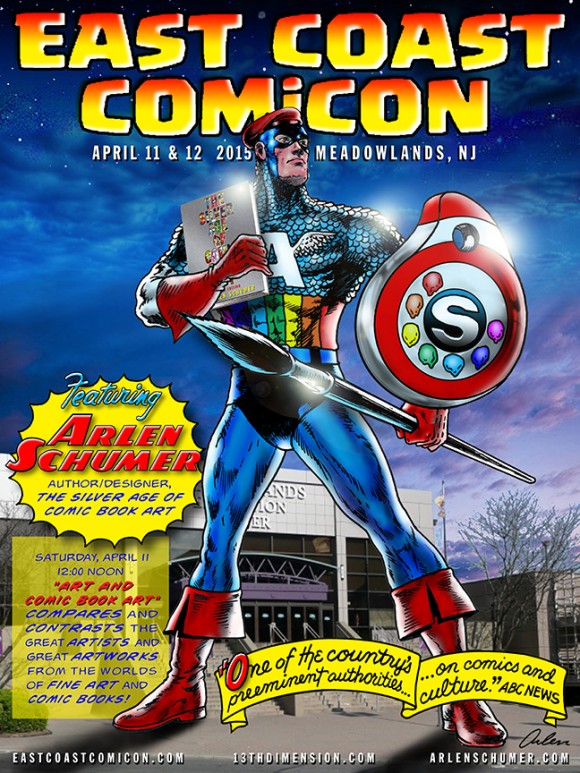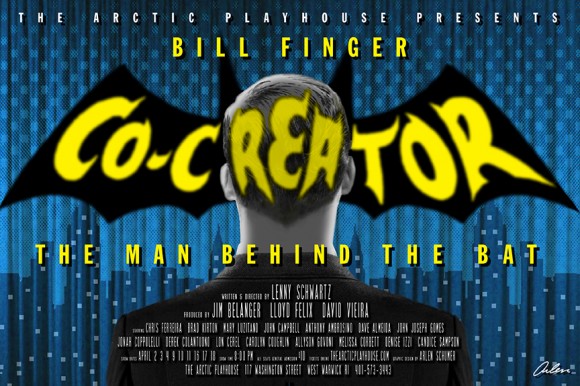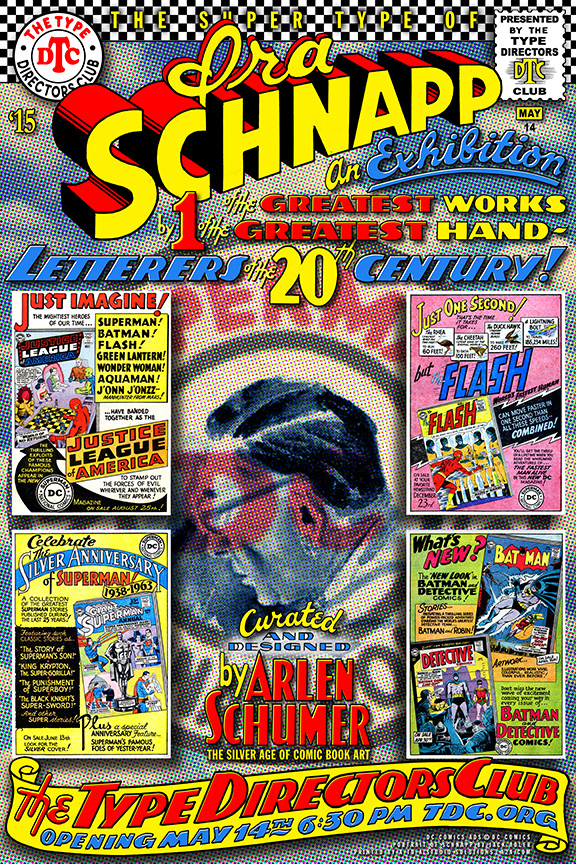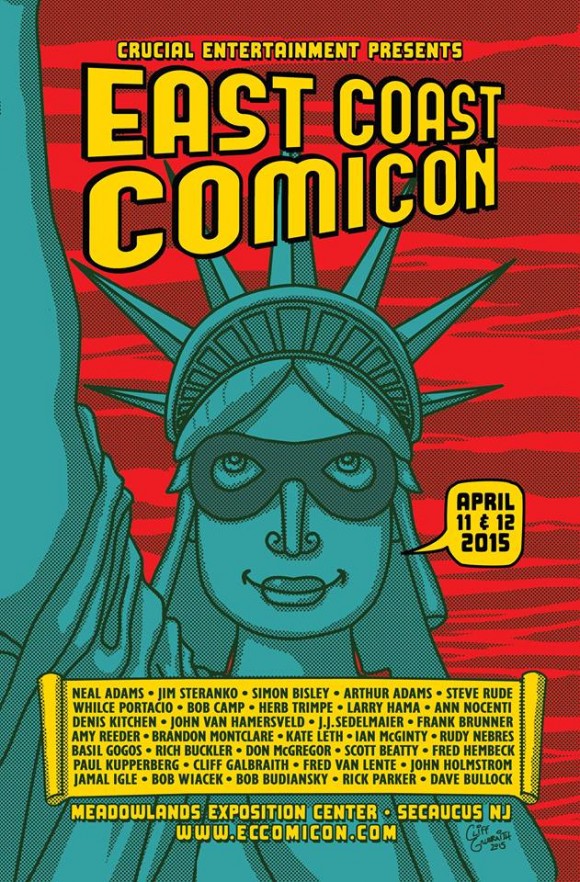Comics maven Arlen Schumer will be presenting his Art & Comic Book Art lecture at EAST COAST COMICON.
Plus, he’ll also be selling copies of his excellent The Silver Age of Comic Book Art, one of my fave coffee-table books.
Arlen’s love of comics is as abiding as anyone I know, especially when it comes to the creators of yore. Today, he gets center stage, joining other guests like Fred Van Lente, Fred Hembeck and Kate Leth & Ian McGinty — whom we’re spotlighting ahead of the show.
For the full guest list, click here. Neal Adams! Jim Steranko! Bob Camp! Larry Hama! Ann Nocenti! And for tickets, click here! East Coast Comicon is at the Meadowlands Exposition Center in N.J. There will be 300 exhibitors, the 1966 Batmobile, cosplay and other contests and so much more!
—
Dan Greenfield: What’s your Secret Origin?
Arlen Schumer: I did my “Secret Origin” as an autobiographical single-page comic story, “Man & Superman,” printed as the last page of my book, The Silver Age of Comic Book Art. But here’s a text version:
I grew up in Fair Lawn, N.J., a great place to grow up in the early-mid ‘60s, with equal parts bucolic American suburbia and small-town Rockwellian, pop culture ambiance—everything from an uber-Jewish deli like Petak’s to Plaza Toy & Stationery, which had a classic 20th Century soda fountain: it was there, after school, that I read all the comic books of my youth while drinking chocolate egg creams (with a pretzel log, natch). And because Fair Lawn, like all of New Jersey, was in the shadow of New York City, I grew up on all that pop culture through television, not just the three networks but the three local stations that showed everything from the old Universal monster movies to The Little Rascals to The Three Stooges to the George Reeves Superman TV series!
One of those local TV shows, a children’s show called Diver Dan, which was filmed in black & white to look like it took place underwater—the actor, in a deep-sea diver’s suit (with a helmet that never revealed his face, so he was like a superhero), walked slowly like he was underwater, surrounded by pop fish hanging by wires—triggered my interest in drawing, as I watched my brother draw him first, and copied him. I’ve been drawing ever since! And collecting, reading and studying comic books, which gave me the foundation on which I built my career on, as an illustrator and comic book art historian.
I was the “class artist” all through my school years, always doing “visual aids” for extra credit, and finding ways to incorporate my love of comics into my class assignments—like doing an oral report in 8th grade on the lawsuit between Superman and Captain Marvel! In high school (Fair Lawn HS, Class of ’76), I was fortunate to have a really great commercial art teacher who exposed me to that world, its techniques and materials, which gave me the confidence to attempt things outside of school—like being the art director of Batmania magazine, the fanzine for Batman fans.
That teaching gave me a leg up when I went to art school after graduation, Rhode Island School of Design—which I chose because the great comic-book artist Walt Simonson had just taken the comic-book world by storm in the early ‘70s with his Manhunter strip; the letter column in his first issue said that he was a recent graduate of RISD—so that’s where I went! But once I got there, I majored in graphic design vs. illustration, because I was intrigued by graphic design’s verbal-visual makeup—the same words and pictures combination that was what comic book art was all about.
After RISD, I went to New York City and began my professional career—starting at WNET Channel 13 doing TV graphics, then at NBC doing the graphics for Late Night with David Letterman, followed by stints in ad agencies—including working for my comic-book artist childhood idol, Neal Adams, at his commercial art studio, Continuity Associates—which was like going to graduate school—and getting paid for it!
At the time, Neal was doing mostly advertising production art (comps, storyboards, animatics), which was preventing him from taking on all the finished-illustration comic book-styled ads that were coming in; I reasoned one guy could make a pretty good living just on the work he was turning away, and that that was what we set out to do full-time upon leaving Continuity in ’86. Neal had previously done, I thought, the best comic advertising to date; I could never compete with him on a pure drawing level (who could?), but I thought I could differentiate our work by emphasizing overall graphic design and good hand-lettering, due largely to my graphic design education at RISD.
I had no desire to do comic-book art for the companies, as I was probably just too slow for the field, and didn’t really have the burning desire to tell stories anyway — I had more of an illustration/poster design mentality. My goal was to bring comic art into the commercial art world with the same impact Roy Lichtenstein had brought it into the fine-art world; here is where I felt I could do my part to uplift the medium in the eyes of the mainstream.
Since ’86, I’ve created hundreds of images, with my most visible mainstream work probably being a “screaming woman” illustration for HBO’s Tales From The Crypt that appeared throughout the ’90’s, a series of Trojan Man ads (’90-’93), magazine covers & illustrations for major consumer magazines & newspapers, like Forbes, Publishers Weekly, The New York Times Magazine, New York Magazine, People, Entertainment Weekly, Rollingstone, TV Guide, Time and Newsweek.
I’m probably only known to the comic-book world through a series of ads for Three Musketeers that appeared in comics from ’90-’92, and a series of Superman and Batman pop-up greeting cards for PopShots that came out in ’94 and ’95.
Perhaps better known are the projects I’ve done in the area of comic-book art history: convincing Print magazine to devote a special issue to comics in 1988; writing and designing a series of ten 55”x27” exhibition panels on The Graphic History of Batman in ’97 for the (sadly defunct) Words & Pictures Museum, and six more in ’98 on The Art History of Superman; and Neal Adams: The Sketch Book, published by Vanguard in ’99. Also for Vanguard, I wrote and designed the 16-page color sections in the books The Amazing World of Carmine Infantino (published in 2000), and Curt Swan: A Life in Comics (2002).
I edited & designed a confutable art book based on the legendary TV series, Rod Serling’s The Twilight Zone, treating its black & white TV images as art photography, and its dialogue & narration as poetry, called Visions From The Twilight Zone, published by Chronicle Books in ’91.
And my coffee-table comic book art history book, The Silver Age of Comic Book Art (Collectors Press), about comic book art in the 1960s, won the Independent Book Publishers Award for Best Pop Culture Book of 2003; I just republished it as a deluxe, revised hardcover, available signed & sketched-in.
What are you working on now?
My art show just opened at The Rosewood Arts Centre in Kettering, Ohio. I just designed the poster for the play about Bill Finger, CO-CREATOR. May 1-3, I go to Guatemala to sign books & lecture three times in three days for their XPO Comicon.
On May 14, a dream come true: getting to lecture on, and design and curate an exhibit of the works of Ira Schnapp at the Type Directors Club of NY; my exhibit designs are going to BLOW PEOPLES’ MINDS!!!
June 6-7, I’ll be back at the Jacob Javits Center for Special Edition NYC, signing Silver Age books and (hopefully) giving the Schnapp lecture there, because the exhibit at the Type Directors Club (on 36th between 8th & 9th, right near the Javits) goes on though the summer!
What’s your favorite convention memory?
Stepping into the Grand Ballroom of the Commodore Hotel in NYC (now the Grand Hyatt Hotel, next to Grand Central) on July 3, 1973, the first day of the Phil Seuling NY Comic Convention—and my first comicon at age 15! It felt like stepping into Madison Square Garden! The first thing I saw, across the chasm of the ballroom floor, mounted high on the opposite wall, was an enormous poster of Mike Kaluta’s cover for The Shadow #1 that debuted that summer, that came across to awestruck, 15-year-ol’ me as one of the greatest comic book covers of all time (and STILL is)!
What’s the first comic book you ever got? Do you still have it?
The first comic book I remember seeing was the 1963 Superman 25th Anniversary Annual, with that great Curt Swan statue (rendered in gray wash tones by DC’s head colorist, Jack Adler)—I was 5 years old and at summer sleepaway camp! Whether the one I still have is the same one from 52 years ago? Who knows? 🙂
What comics do you recommend right now?
Allred’s Silver Surfer, Tony Puryear’s Concrete Park, Amy Reeder’s Rocket Girl, Dean Haspiel’s The Fox, the new Love & Rockets, the new Sandman illustrated by JH Williams III, and the graphic novels The Sculptor by Scott McCloud, Jules Feiffer’s Kill My Mother, and Richard McGuire’s Here.
—
Arlen Schumer will be at East Coast Comicon at the Meadowlands Expo Center in N.J. Come meet him! Click here for tickets!

